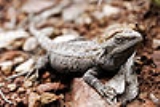
Pogona minor
Encyclopedia
Pogona minor is a species of agamid
lizard
from a group commonly known as Bearded Dragon
s, and is found on the southwest coast and interior of Western Australia
. This taxonomic name includes the widespread type known as Western bearded dragon, Pogona minor minor, and the subspecies
, Pogona minor minima
, confined to the Wallabi Group
of islands.
-like colour, either blending into their environment or presenting a brighter display during interaction with others. It is similar in appearance to Pogona nullarbor and Caimanops amphiboluroides (Mulga Dragon), but is distinguished by a smaller head size, and the arrangement of spines on the underside and neck. The Western bearded dragon is widespread in Southwest Australia
and central deserts, the range includes semiarid regions such as woodland or heathland, and arid desert or coastal dunes. This subspecies also occurs on Dirk Hartog Island
.
Pogona minor minima is found on West, North, and East Wallabi Islands, Houtman Abrolhos
.
These dragons display a behaviour common to other Pogona
species, the dragon will wave its hand to trigger a response from a potential predator. Another typical behaviour of is that of 'head-bobbing' amongst males, perhaps related to dominance within their social order. It is often seen basking on fence posts.
Agamidae
Agamids, lizards of the family Agamidae, include more than 300 species in Africa, Asia, Australia, and a few in Southern Europe. Many species are commonly called dragons or dragon lizards. Phylogenetically they may be sister to the Iguanidae, and have a similar appearance. Agamids usually have...
lizard
Lizard
Lizards are a widespread group of squamate reptiles, with nearly 3800 species, ranging across all continents except Antarctica as well as most oceanic island chains...
from a group commonly known as Bearded Dragon
Pogona
Pogona are a genus of lizards containing seven species, which are often known by the common name bearded dragons. The term "bearded dragon" is most commonly used to describe the Central Bearded Dragon. Members of this genus live in the arid, rocky, semi-desert regions and dry open woodlands of...
s, and is found on the southwest coast and interior of Western Australia
Western Australia
Western Australia is a state of Australia, occupying the entire western third of the Australian continent. It is bounded by the Indian Ocean to the north and west, the Great Australian Bight and Indian Ocean to the south, the Northern Territory to the north-east and South Australia to the south-east...
. This taxonomic name includes the widespread type known as Western bearded dragon, Pogona minor minor, and the subspecies
Subspecies
Subspecies in biological classification, is either a taxonomic rank subordinate to species, ora taxonomic unit in that rank . A subspecies cannot be recognized in isolation: a species will either be recognized as having no subspecies at all or two or more, never just one...
, Pogona minor minima
Pogona minor minima
Pogona minor minima is an agamid lizard found only on islands at Houtman Abrolhos, and commonly named for this location; the Abrolhos Bearded Dragon. It is closely related to other Bearded dragons found in Western Australia....
, confined to the Wallabi Group
Wallabi Group
The Wallabi Group is the northern-most group of islands in the Houtman Abrolhos. Nominally located at , it is 58 kilometres from the Australian mainland, and about 9 kilometres from the Easter Group....
of islands.
Description
Pogona minor minor are large lizards, 38 cm in length (15 cm from snout to vent), P. minor minima is slightly smaller. All Bearded dragons have a chameleonChameleon
Chameleons are a distinctive and highly specialized clade of lizards. They are distinguished by their parrot-like zygodactylous feet, their separately mobile and stereoscopic eyes, their very long, highly modified, and rapidly extrudable tongues, their swaying gait, the possession by many of a...
-like colour, either blending into their environment or presenting a brighter display during interaction with others. It is similar in appearance to Pogona nullarbor and Caimanops amphiboluroides (Mulga Dragon), but is distinguished by a smaller head size, and the arrangement of spines on the underside and neck. The Western bearded dragon is widespread in Southwest Australia
Southwest Australia
Southwest Australia is a biodiversity hotspot that includes the Mediterranean forests, woodlands, and scrub ecoregions of Western Australia. The region has a wet-winter, dry-summer Mediterranean climate, one of five such regions in the world...
and central deserts, the range includes semiarid regions such as woodland or heathland, and arid desert or coastal dunes. This subspecies also occurs on Dirk Hartog Island
Dirk Hartog Island
Dirk Hartog Island is an island off the Gascoyne coast of Western Australia, within the Shark Bay World Heritage Area. It is about 80 kilometres long and between 3 and 15 kilometres wide and is Western Australia's largest and most western island. It covers an area of 620 square kilometres and is...
.
Pogona minor minima is found on West, North, and East Wallabi Islands, Houtman Abrolhos
Houtman Abrolhos
The Houtman Abrolhos is a chain of 122 islands, and associated coral reefs, in the Indian Ocean off the west coast of Australia. Nominally located at , it lies about eighty kilometres west of Geraldton, Western Australia...
.
These dragons display a behaviour common to other Pogona
Pogona
Pogona are a genus of lizards containing seven species, which are often known by the common name bearded dragons. The term "bearded dragon" is most commonly used to describe the Central Bearded Dragon. Members of this genus live in the arid, rocky, semi-desert regions and dry open woodlands of...
species, the dragon will wave its hand to trigger a response from a potential predator. Another typical behaviour of is that of 'head-bobbing' amongst males, perhaps related to dominance within their social order. It is often seen basking on fence posts.

